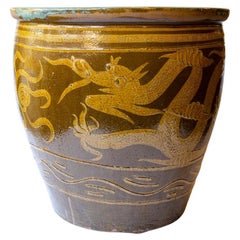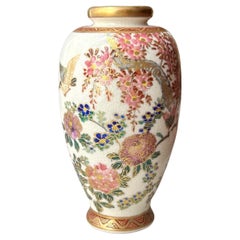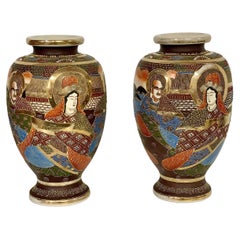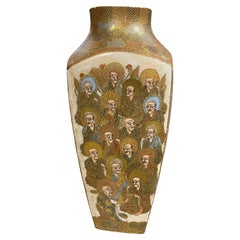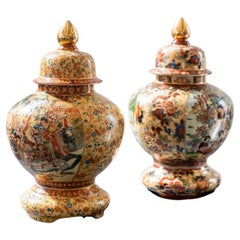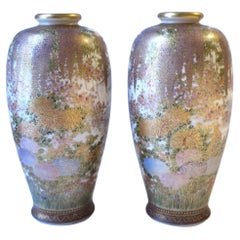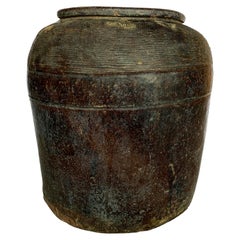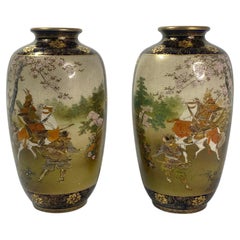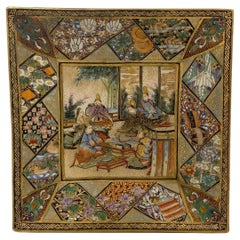Satsuma Ceramics
1
9
to
6
2
9
9
9
12
9
5
1
2
1
9
4
2
2
8
8
6
2
19
17
11
11
10
Period: 20th Century
Creator: Satsuma
Antique circa 1900 Chinese Very Large Earthenware Dragon Planter Plant Egg Pot
By Satsuma
Located in Autonomous City Buenos Aires, CABA
Antique Chinese glazed ceramic egg cup. This brown glazed stoneware urn displays vibrant turquoise tones within. Large egg planter currently being used as ...
Category
Early 1900s Chinese Chinese Export Antique Satsuma Ceramics
Materials
Earthenware
Meiji Period Diminutive Satsuma Baluster Vase.
By Satsuma
Located in Vero Beach, FL
Meiji Period Diminutive Satsuma Baluster Vase.
This Japanese Satsuma vase from the late Meiji period is hand painted and gilt decorated with a Japanese landscape in exquisite detail...
Category
20th Century Japanese Meiji Satsuma Ceramics
Materials
Porcelain
Pair of Porcelain Japanese Satsuma 'Moriage' Gilt Vases
By Satsuma
Located in LA CIOTAT, FR
This handsome pair of 20th century glazed and gilded Japanese Satsuma vases, with their vivid, jewel-like colours and elegant baluster-shaped forms, feature the traditional Japanese ...
Category
20th Century Japanese Satsuma Ceramics
Materials
Porcelain
Japanese Antique Satsuma Pottery Buddhist Monks Vase with Shimazu Crest Mark
By Satsuma
Located in Studio City, CA
A beautiful Japanese Satsuma pottery studio vase featuring multiple kesa-clad enlightened Buddhist monks on each side of the vase. The piece is finely detailed with rich raised gilt highlights throughout and beautifully decorated in gold and various hand painted other colors.
From the Meiji period (1868-1912).
This piece has the all-important Shimazu Family crest mark (red circle with a cross inside) on the base authenticating the work as an old and original Satsumaware work. The mark shows the pottery was made under the rule of the Shimazu clan.
From a Los Angeles Collection...
Category
Early 20th Century Japanese Meiji Satsuma Ceramics
Materials
Earthenware, Pottery
Hand-decorated Chinese Royal Satsuma ceramic vases, 1960s
By Satsuma
Located in Manzano, IT
Hand-decorated Chinese Royal Satsuma ceramic vases, 1960s
Stile Vintage
Periodo del design 1960 - 1969
Production period Unknown, 1960 - 1969
Year of manufacture 1960
Country of prod...
Category
1960s Chinese Vintage Satsuma Ceramics
Materials
Ceramic
Japanese Satsuma Vases, Pair
By Satsuma
Located in New York, NY
A gorgeous pair of Japanese earthenware Satsuma vases, hand-painted, Meiji period, circa early-20th century, Japan. Vases' beautiful decoration is high-qu...
Category
Early 20th Century Japanese Meiji Satsuma Ceramics
Materials
Earthenware
Satsuma Earthenware Covered Box, by Kinkozan
By Satsuma
Located in West Palm Beach, FL
A Satsuma Earthenware covered box,
by Kinkozan,
Japanese, Meiji period (1868-1912)
decorated in polychrome enamels and gilt over a clear, crackled glaze, delicately painted with s...
Category
Early 1900s Antique Satsuma Ceramics
Materials
Earthenware
Antique Japanese Satsuma Pottery Miniature Cabinet Vase
By Satsuma
Located in Philadelphia, PA
A fine antique Japanese Satsuma porcelain miniature vase.
With enameled scenes to all sides and rich raised gilt highlights throughout.
...
Category
20th Century Japanese Meiji Satsuma Ceramics
Materials
Pottery
Spectacular 3 Piece Japanese Satsuma Peacock Vases and Tea Pot Set
By Satsuma
Located in Miami, FL
Antique, Meji Era, Japanese 3pc. SATSUMA Double Peacock Vase, Single Peacock Vase and Tea Pot with Flowered Lid and Bamboo Handle. There are no chips, cracks, or repairs,
Tall Va...
Category
Early 20th Century Japanese Meiji Satsuma Ceramics
Materials
Ceramic
Related Items
Antique ca 1900 Japanese Satsuma Vase Richly Decorated Marked Miniature
Located in Amsterdam, Noord Holland
Description
A Japanese Satsuma teapot and cover marked base, miniature
Condition
Overall condition restoration to rim. Size 60mm high
Period
19...
Category
19th Century Japanese Meiji Antique Satsuma Ceramics
Materials
Porcelain
Antique Chinese Brown Glazed Ceramic Salty Egg Jar, c.1900
Located in Jimbaran, Bali
This antique Jar dating to the early 1900s once served the purpose of crafting salty eggs. The jar features a wonderful brown glaze. There is a ridged pattern finish near to the Jar'...
Category
Early 20th Century Chinese Qing Satsuma Ceramics
Materials
Ceramic
Chinese Shiwan Green Glazed Ceramic Jar / Planter, c. 1900
Located in Jimbaran, Bali
A wonderful green glaze typical of Chinese "Shiwan" pottery adorns this early 20th Century Chinese storage jar. The jar likely occupied a private home to store grains or other househ...
Category
Early 20th Century Chinese Qing Satsuma Ceramics
Materials
Ceramic
Satsuma Japanese Meiji Miniature Enameled Teapot Kozon Mark
By Satsuma
Located in Bishop's Stortford, Hertfordshire
An exceptional Japanese Satsuma miniature spool shaped pottery teapot and cover finely hand enameled with Kozon mark and dating from around 1880. This delightful teapot has an invers...
Category
19th Century Japanese Meiji Antique Satsuma Ceramics
Materials
Pottery
A pair of large Meiji period Satsuma Rouleau vases
Located in London, GB
A pair of large Meiji period Satsuma Rouleau vases
Japanese, Late 19th Century
Height 54.5cm, diameter 24cm
These beautiful Satsuma-ware vases were made ...
Category
Late 19th Century Japanese Meiji Antique Satsuma Ceramics
Materials
Earthenware
Large Blue and White Jardinière Planter with Dragon and Phoenix Bird
Located in Lambertville, NJ
Classic Chinese blue and white porcelain jardinière with hand painted cobalt decoration. The white porcelain with painted Dragon a...
Category
Early 20th Century Chinese Chinese Export Satsuma Ceramics
Materials
Porcelain
Antique Chinese Cinnabar Dragon Vase, circa 1920
Located in Big Flats, NY
An antique Chinese Cinnabar vase offers dragon and foliate decoration, c1920
Measures - 8"h x 3.25"diameter.
Category
20th Century Chinese Satsuma Ceramics
Materials
Metal
Satsuma earthenware vase by kinkozan, Meiji period
By Kinkozan
Located in Tel Aviv - Jaffa, IL
the body of this small marvelous vase is painted with a scene of a puppet show vendor with his wood backpack, on top of the backpack there are toys and dolls, he is surrounded with a group of 6 children, and on the background you can see a village.
on the other side of the vase there is an amazing painting of flowers and on the sides there are two amazing strong pine trees, the amorphous background is decorated in a "Tortoiseshell" color and design that gives it a real character and which is quite rare to see on satsuma pottery.
all the vase is over richly overpainted over the glaze with gold, which gives it its depth and realism.
signed Kyoto Kinkozan zo, and sealed Kinkozan zo
Kyoto’s Satsuma:
The painting technique used in Kyoto’s Satsuma-style ware is said to be the invention of the sixth generation Kinkōzan Sōbei (1824–1884). The Kinkōzan were a famous family of Kyoto Awataguchi potters who made ceramics that were used at Shōren'in, a temple closely tied to the imperial family, and by the shoguns of the Edo government. In fact the shogun is said to have granted them the name Kinkōzan. With the upheavals at the end of the Edo period, however, and the reforms of the subsequent Meiji government, the potters lost their traditional patrons and had to develop new markets.
Just at that time, the visit of a certain Westerner is said to have decided them to embark on overseas trade. By 1870, they had perfected Kyō Satsuma...
Category
1890s Japanese Meiji Antique Satsuma Ceramics
Materials
Gold
Chinese Export Brush Pot or Bitong Porcelain hand painted, Qing Circa 1900
Located in Lincoln, Lincolnshire
A Chinese Export porcelain brush pot or bitong, hand painted in a blue and white figural pattern and dating to the turn of the 19th Century, late Qing period, Circa 1900.
This piece is well potted in an over square, circular shape with the diameter being wider than the height. This is a heavy piece weighing over 2.5 Kg unpacked.
It is beautifully painted in varying shades and tones of under-glaze cobalt blue showing various figures in an outdoor scene with bats, fences, trees and mountains.
The piece has a bi-ring base, which is a typical feature of Kangxi period brush pots, though this piece is Kangxi revival in its style.
Overall a very decorative, beautifully proportioned, hand painted blue and white Chinese porcelain brush pot.
Category
Late 19th Century Chinese Chinese Export Antique Satsuma Ceramics
Materials
Porcelain
Antique Japanese Meiji Satsuma Painted Vase
By Satsuma
Located in LA CIOTAT, FR
A petite and beautiful hand-decorated ceramic baluster vase, painted all around with traditional Japanese motifs, including native flora, birds and bamboo stems on a creamy glazed background. The colour palette is bold and bright, with highlights of green, red and blue, together with plentiful gilt relief...
Category
19th Century Japanese Meiji Antique Satsuma Ceramics
Materials
Ceramic
Large Chinese Porcelain Five Dragon Meiping Vase, Modern, China
Located in Austin, TX
A large and powerful Chinese famille rose enameled porcelain "Five Dragon" meiping vase, modern, China.
The oversized vase of traditional meiping form, with a splayed foot supporting a baluster shaped body with high shoulders, short, narrow neck, and rolled mouth rim.
The large vase decorated with five dragons molded in relief. Their bodies painted in vibrant overglaze famille rose enamels of reds, greens, yellows and turquoise.
The dragons portrayed dancing in the sky among flames and clouds. Their bodies twisting and writhing, claws extended, tails coiled, some with mouths open in triumphant roars. The main dragon in red, and portrayed to more directly face the viewer.
The dragons dance against a white ground sky. The blank sky broken up by overglaze red painted stylized clouds and flames. The foot decorated with a band of crashing waves. A stylized lotus blossom surrounds the base of the neck. The neck with a band of scrolling flowers and vines against a yellow ground.
The underside of the large vase with an apocryphal "Da Qing Qianlong Nian Zhi...
Category
Early 2000s Chinese Qing Satsuma Ceramics
Materials
Porcelain
19th Century Japanese Satsuma Porcelain Water Well Bucket, Wishing Well Vase
By Satsuma
Located in Vero Beach, FL
This Japanese porcelain vase is barrel shaped with a yolk handle. It is both finely and intricately hand painted. It pictures groups of scholars with scrolls dressed in elaborate brocade kimonos...
Category
Late 19th Century Japanese Meiji Antique Satsuma Ceramics
Materials
Porcelain
H 5 in W 4.13 in D 4.13 in
Previously Available Items
Pair Satsuma pottery vases. Samurai on horses. Kinkozan, Meiji Period.
By Satsuma
Located in Gargrave, North Yorkshire
Pair of Satsuma pottery vases, Kinkozan, c. 1900. Meiji Period. Both vases, well painted with panels of Samurai riding horses, with attendants, beneath blossoming prunus trees. The r...
Category
Early 1900s Japanese Meiji Antique Satsuma Ceramics
Materials
Earthenware
Satsuma pottery dish. Kanzan, c. 1900, Meiji Period
By Satsuma
Located in Gargrave, North Yorkshire
Satsuma pottery square dish, signed Kanzan, c. 1900, Meiji Period. Painted to the centre, with a scene of figures seated around tables. The border with...
Category
Early 20th Century Japanese Meiji Satsuma Ceramics
Materials
Earthenware
Satsuma Earthenware Vase, Kinkozan, Meiji Period
By Satsuma
Located in Gargrave, North Yorkshire
Satsuma earthenware vase, Kinkozan, Meiji Period. The large vase, beautifully hand painted with twin panels of Bijin conversing in garden settings, before a mountainous river landsca...
Category
Early 1900s Japanese Meiji Antique Satsuma Ceramics
Materials
Earthenware
Pair of Large, Meiji Period, Japanese Satsuma Vases with Opulent Gilt
By Satsuma
Located in Vero Beach, FL
Presenting a superb pair of Japanese Satsuma vases. They are crafted with high quality workmanship and unsurpassed gilding. The decorations are extremely detailed and the panels are ...
Category
Early 20th Century Japanese Meiji Satsuma Ceramics
Materials
Porcelain
Japanese Porcelain Center Bowl
By Satsuma
Located in Los Angeles, CA
1900 - 1930's Very Fine Large Japanese Porcelain Center Bowl. Gilded and Hand Painted. Signed by Satsuma.
Category
1930s Japanese Vintage Satsuma Ceramics
Materials
Porcelain
Satsuma ceramics for sale on 1stDibs.
Satsuma ceramics are available for sale on 1stDibs. These distinctive items are frequently made of ceramic and are designed with extraordinary care. There are many options to choose from in our collection of Satsuma ceramics, although brown editions of this piece are particularly popular. If you’re looking for additional options, many customers also consider ceramics by Makuzu Kozan, Imari Porcelain, and Kinkozan. Prices for Satsuma ceramics can differ depending upon size, time period and other attributes — on 1stDibs, these items begin at $580 and can go as high as $1,726, while a piece like these, on average, fetch $1,111.
Creators Similar to Satsuma
Questions About Satsuma Ceramics
- What is a Japanese Satsuma vase?1 Answer1stDibs ExpertOctober 12, 2021A type of Japanese pottery originated from Satsuma province in Japan is termed as Satsuma ware. A vase of this kind is known as a Satsuma vase. An interesting fact about Satsuma ware is that they feature a "makers mark" or marking as a key to help collectors unlock the value, age and authenticity of the piece. Shop a range of antique and vintage Japanese vases on 1stDibs.
- How do I date a Satsuma vase?1 Answer1stDibs ExpertMarch 22, 2022To date a Satsuma vase, study its mark. Vases made before World War II normally feature a mark in Japanese. A vase that says "Royal Satsuma" likely dates back to the late 20th century. You'll find a variety of expertly vetted Satsuma vases on 1stDibs.
- 1stDibs ExpertApril 5, 2022Satsuma porcelain or pottery includes a maker’s mark with the name of the person who made the item. Japanese numbers may also indicate that a Satsuma piece was part of a collection. Genuine Satsuma pieces will not have a “Made in Japan” label and should only include Japanese characters. When in doubt, work with a certified appraiser to determine the authenticity of your Satsuma piece. Find a variety of expertly vetted Satsuma porcelain and pottery collectibles on 1stDibs.
- Is Satsuma pottery valuable?1 Answer1stDibs ExpertApril 26, 2024Yes, some Satsuma pottery is valuable. The age, type, style and condition will determine how much a particular piece is worth. In addition, the history of ownership may also make a piece more valuable. For example, if a piece was previously in the collection of a notable person, such as a member of the Japanese Imperial Family, it may be worth more. To get an estimated value for a particular piece, consult a certified appraiser or knowledgeable antiques dealer. Find a range of Satsuma pottery on 1stDibs.
- 1stDibs ExpertFebruary 1, 2024One way to tell if your Satsuma vase is valuable is to look for markings on it. The oldest and typically most expensive pieces will usually have the Shimazu family crest — a circle with a cross through it — hand-painted on the bottom. If the piece is stamped with the marking or says "Made in Japan" in the Roman alphabet, it is a newer vase. Factors like the style of the vase and its condition will also impact its price. It's a good idea to have a certified appraiser or knowledgeable dealer evaluate your vase to determine its value. Find a variety of Satsuma vases on 1stDibs.
